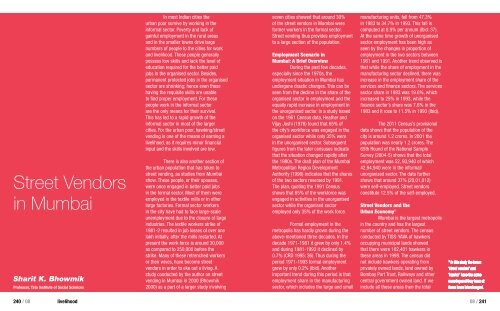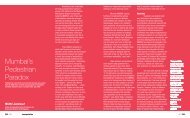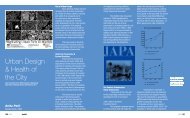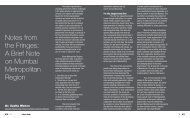Street Vendors in Mumbai - Urban Design Research Institute
Street Vendors in Mumbai - Urban Design Research Institute
Street Vendors in Mumbai - Urban Design Research Institute
You also want an ePaper? Increase the reach of your titles
YUMPU automatically turns print PDFs into web optimized ePapers that Google loves.
number should be 250,000 or more. TheNational Policy for <strong>Urban</strong> <strong>Street</strong> <strong>Vendors</strong>(2006) states that around 2% of the totalpopulation of a city is engaged <strong>in</strong> streetvend<strong>in</strong>g. By this measure the total numberof street vendors should be around250,000. <strong>Street</strong> vendors thus constitutea large section of the urban work force,and perhaps the most victimised.The total employment providedthrough street vend<strong>in</strong>g becomes largerif we consider the fact that it susta<strong>in</strong>scerta<strong>in</strong> <strong>in</strong>dustries by market<strong>in</strong>g theirproducts. A lot of the goods sold by streetvendors, such as clothes and hosiery,leather and moulded plastic goods,household goods and some items offood, are manufactured <strong>in</strong> small scale orhome-based <strong>in</strong>dustries. These <strong>in</strong>dustriescollectively provide employment to alarge number of workers but they couldhave hardly marketed their products ontheir own. In this way street vendors helpsusta<strong>in</strong> employment <strong>in</strong> these <strong>in</strong>dustries.<strong>Street</strong> vendors <strong>in</strong> <strong>Mumbai</strong>,as elsewhere, are ma<strong>in</strong>ly those whoare unable to get regular employment.This section of the urban poor tries tosolve their problems through their ownmeagre resources. Unlike other sectionsof the urban population they do notdemand that government create jobs forthem, nor do they engage <strong>in</strong> begg<strong>in</strong>g,steal<strong>in</strong>g or extortion. They try to livetheir life with dignity and self-respectthrough hard work and limited capital.The poorer sections too are ableto procure their basic necessities ma<strong>in</strong>lythrough street vendors, as the goodssold are cheap. The study by the authormentioned earlier showed that the lower<strong>in</strong>come groups spend a higher proportionof their <strong>in</strong>come <strong>in</strong> mak<strong>in</strong>g purchasesfrom street vendors ma<strong>in</strong>ly because theirgoods are cheap and thus affordable.Had there been no street vendors <strong>in</strong> thecities the plight of the urban poor wouldbe worse than what it is at present.In this way one section of theurban poor, namely, street vendors,helps another section to survive. Hencethough street vendors are viewedas a problem for urban governance,they are <strong>in</strong> fact the solution to someof the problems of the urban poor. Byprovid<strong>in</strong>g cheaper commodities streetvendors are <strong>in</strong> effect provid<strong>in</strong>g subsidyto the urban poor, someth<strong>in</strong>g that thegovernment should have done.Profile of <strong>Street</strong> <strong>Vendors</strong>In the follow<strong>in</strong>g sections we shallprovide a profile of the street vendors<strong>in</strong> <strong>Mumbai</strong>. The data presented, unlessmentioned otherwise, is presented froma study conducted by the author <strong>in</strong> 2000.This study has been updated recently.The other sources of data are the studyconducted by TISS-YUVA <strong>in</strong> 1998 and astudy conducted by SNDT University <strong>in</strong>collaboration with ILO <strong>in</strong> 2001. TISS-YUVA had conducted a survey of streetvendors on BMC lands while the othertwo studies were based on samples. Wehave quoted more recent data from studyconducted by the author <strong>in</strong> 2010 as anupdate of the 2000 study of seven cities.Social CompositionThe sex ratio from our surveyof 2010 shows that 27% of the streetvendors are females. Around half of thestreet vendors (51%) belong to OtherBackward Classes and around 12% areScheduled Castes. Tribals form only 5%of the population. The open categoriesconstitute Only 15% of the vendorscovered had resided less than 15 years<strong>in</strong> the state. The majority were residentsof <strong>Mumbai</strong> for a long period of time.The literacy levels of the vendorsshowed that 25% were illiterate whilearound 22% have primary education.Around 32% of the hawkers have studiedup to the secondary school and the resthave higher educational qualifications.Some of the hawkers were graduates(3%) who had taken up this professionas no other work was available.The TISS-YUVA study foundthat there was a positive l<strong>in</strong>k betweeneducational level and <strong>in</strong>come. The bettereducated sold goods which were moreexpensive and hence more profitable.In our study too we found that illiteratevendors, especially the females, soldvegetables and flowers <strong>in</strong> small quantities.IncomeThe TISS-YUVA survey foundthat the average <strong>in</strong>come of hawkers <strong>in</strong>1998 ranged from Rs. 50 to Rs. 80 perday. The SNDT-ILO (2001) study did notcollect data on <strong>in</strong>come of the vendors.Instead it made a list of the expenditure.Accord<strong>in</strong>g to this study, the averagemonthly expenditure of a street vendoris Rs. 2088 per month (approximate Rs.66 per day). In our study (2000) we triedto explore how much vendors sell<strong>in</strong>gdifferent products earn. Petty vegetablevendors, ma<strong>in</strong>ly women, operat<strong>in</strong>g fromthe streets of the work<strong>in</strong>g class areas<strong>in</strong> Central <strong>Mumbai</strong> (Parel, Lal Bagh etc.)earned Rs. 35 to Rs. 50 per day. The<strong>in</strong>come of male vendors varied from Rs.50 to Rs. 100 per day. There are caseswhere the <strong>in</strong>come is higher and a fewlicensed hawkers even pay <strong>in</strong>come tax.These are exceptions rather than the rule.The study of 2010 showed10% earned less than Rs. 140 a dayand 47% earned between Rs. 141 andRs 200 a day. The upper <strong>in</strong>come groupconstituted 17% who earned betweenRs. 220 to Rs. 350 a day. These figuresare undoubtedly a jump <strong>in</strong> <strong>in</strong>come ascompared to ten to twelve years ago.However if we take <strong>in</strong>to account that them<strong>in</strong>imum wage for unskilled workers <strong>in</strong><strong>Mumbai</strong>, as per notification of the LabourDepartment, was Rs. 217 per day <strong>in</strong>2010 the impressive <strong>in</strong>crease <strong>in</strong> <strong>in</strong>comeis not that impressive. Most vendors donot earn the equivalent of a need basedm<strong>in</strong>imum wage. Moreover if we take<strong>in</strong>to account the number of dependentseach street vendor has <strong>in</strong> his residenceand <strong>in</strong> his village, the <strong>in</strong>come if furthereffaced. We found that the averagenumber of dependents per hawker was3 <strong>in</strong> <strong>Mumbai</strong> or <strong>in</strong> their villages of orig<strong>in</strong>.We must also po<strong>in</strong>t out thatthese figures are pre-rent. In other wordsaround 10% of the <strong>in</strong>come of the streetvendors <strong>in</strong> the city is usurped by themunicipal authorities as bribes. Our studyof 2010 found that all street vendors,except those who were very old or weredestitute women, paid bribes to be onthe street. This further effaced their<strong>in</strong>come. The amount of bribe collectedevery year by these corrupt authoritiesamounted to Rs. 400 crores a yeardur<strong>in</strong>g 1998 to 2000. We did not assesthe amount of money collected at thepresent but if we take <strong>in</strong>to account thatthe average bribe collected is around242 / 08 livelihood08 / 243
Rs. 50 a day from each vendor, thetotal amount could be m<strong>in</strong>d boggl<strong>in</strong>g.Work<strong>in</strong>g ConditionsThe work<strong>in</strong>g conditions of thevendors are as tough. Most of them (90%)leave their homes by 6 a.m. or 7 a.m.and return late at night. Around twothirdsof hawkers (65%) reside 10 kms.or more from their places of work. Theyuse the suburban tra<strong>in</strong>s for commut<strong>in</strong>g.Thus we f<strong>in</strong>d that the work<strong>in</strong>g day ofa street vendor, irrespective of her /his <strong>in</strong>come is more than 12 hours.The gruell<strong>in</strong>g conditions ofwork <strong>in</strong>clude be<strong>in</strong>g exposed to sunand ra<strong>in</strong> on the streets. They arealso exposed to fumes from vehiclesevery day. This results <strong>in</strong> respiratorydiseases and other ailments.Women vendors are moreexposed to ailments because of lackof toilet facilities on the streets. Wefound that all women vendors wecovered on Dr. Ambedkar Road, Parel,suffered from kidney problems.The study by SNDT Women’sUniversity and ILO found that 85% ofthe sample suffered from diseasesresult<strong>in</strong>g from tension, such as high bloodpressure (hypertension), hyperacidityand migra<strong>in</strong>e. These are due to thetensions the street vendors face onthe streets. They are on the constantlook out for eviction staff or they haveproblems <strong>in</strong> f<strong>in</strong>ance or they are <strong>in</strong> debt.Women <strong>Street</strong> <strong>Vendors</strong>The <strong>in</strong>come of women vendorsis lower than those of males. Thewomen squatt<strong>in</strong>g on the pavements<strong>in</strong> the work<strong>in</strong>g class area of Central<strong>Mumbai</strong> have started hawk<strong>in</strong>g afterthe closure of the textile mills <strong>in</strong> thatarea. Their husbands had workedas permanent workers <strong>in</strong> the textilemills and are now unemployed forthe past several years. These womenprovide for most of the expenses forthe household through their meagre<strong>in</strong>comes, as they are the ma<strong>in</strong> earners.We have not come across as<strong>in</strong>gle case where a female hawker’stotal household <strong>in</strong>come is more thanRs. 4,000 per month. In most cases(more than 90%) their household<strong>in</strong>come ranges between Rs. 2,000and Rs. 3,500 per month. Undoubtedlythese women belong to families thatare below the urban poverty l<strong>in</strong>e.Women vendors take upthis profession ma<strong>in</strong>ly because ofpoverty. They have fewer resourcesthan the male vendors and their<strong>in</strong>vestment is less. This <strong>in</strong> turn meansthat their <strong>in</strong>come would be lower.Another reason is that they haveto divide their time between earn<strong>in</strong>g onthe street and tak<strong>in</strong>g care of the home.Most women vendors we came across<strong>in</strong> Lalbaug-Parel area worked till 9 amand went home to cook and clean. Theyreturned <strong>in</strong> the late afternoon but wenthome by 9 pm. The males could stay forlonger periods and could sell more. Therewere some cases where the husbandor son took charge when the womanwent home their <strong>in</strong>come was higher.Harassment and BribesWe have discussed aboutthe bribes that the hawkers pay to theauthorities to rema<strong>in</strong> on the streets.<strong>Street</strong> vendors <strong>in</strong> <strong>Mumbai</strong> work underconstant threat of eviction. Occasionallymassive drives are taken up by someover-enthusiastic municipal officers.These people make it a po<strong>in</strong>t to destroythe livelihoods of the work<strong>in</strong>g poor andthey take great pride <strong>in</strong> their ruthlessness.Two of these people merit mention.The first is an officer calledKhairnar and the other is Rokade. Bothwere/are Deputy Commissioners <strong>in</strong>the municipal corporation. Kairnar wasknown as the ‘demolition man’ becauseof his destruction of slums and streetvendors.It is thus surpris<strong>in</strong>g to f<strong>in</strong>d thesame person support<strong>in</strong>g Medha Patker’sprotest aga<strong>in</strong>st demolition of Golibarslum <strong>in</strong> Santa Cruz. One does not knowwhether it is a case of the leopardchang<strong>in</strong>g its spots or sheer hypocrisy.Similarly <strong>in</strong> 2003 a DeputyCommissioner, Rokade, earned notorietywith the work<strong>in</strong>g poor because of hisdestruction of the wares of street vendors.This person said that his aim was tof<strong>in</strong>ancially cripple the street vendorsso that they could not dare to operate<strong>in</strong> future. The same person is backas the head of encroachments and iscont<strong>in</strong>u<strong>in</strong>g <strong>in</strong> the same ruthless manner.We have observed that whatactually happens after these raids isquite different from what people aremade to believe. <strong>Street</strong> vendors returnto their places after a few days. Theyare desperate because the raids makethem paupers. The municipal authoritiesconfiscate their goods without provid<strong>in</strong>ga seizure list or panchanama. As aresult there is no proof of what hasbeen confiscated. This is a violation ofthe rights of these people.If the policeconduct a raid <strong>in</strong> the premises of anotorious crim<strong>in</strong>al a panchanama is madeof the goods confiscated. A street vendorsis treated as even worse than thesecrim<strong>in</strong>als. Our study shows that only 22%of those who were evicted could get backmost of their goods that were confiscated.The raids <strong>in</strong> fact do not solvethe problem of encroachment. In someways they encourage encroachment. Asmentioned earlier, the street vendor whois <strong>in</strong> debt after the raids has to returnto make up for his losses. Moreover therents <strong>in</strong>crease considerably after theseraids. We noticed this after the raids ofKhairnar and Rokade <strong>in</strong> 2000 and 2003,2010-11 respectively. <strong>Street</strong> vendors payhigher bribes to the municipal staff toeither prevent raids or to be forewarnedof raids so that they can escape beforethe demolition men take over. Henceraids actually help the municipaland police officials to earn more.The solution to the problemof encroachment does not lie <strong>in</strong>ruthlessness. The urban poor have forlong been pushed around by <strong>in</strong>sensitivebureaucrats. They don’t realise thatstreet vendors keep people on the streetsmak<strong>in</strong>g them safe for people, especiallywomen. Without street vendors we couldhave an <strong>in</strong>crease <strong>in</strong> crime on the streetsas we can see <strong>in</strong> some cities <strong>in</strong> Africa.In most cities <strong>in</strong> South Africa,Kenya and Nigeria one will not f<strong>in</strong>dany people on the streets after sunsetbecause of fear of robbed. The streetvendors <strong>in</strong> these cities have been evictedto make way for ‘world class cities’.244 / 08 livelihood08 / 245
















